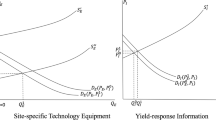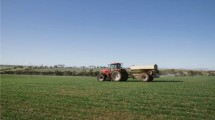Abstract
Variable rate application of fertiliser (VR) is a practice underpinning a profitable grains industry in Australia. We updated the extent of VR adoption through a national survey (n = 1 130) covering all grain growing regions. Three smaller regional-based surveys (n = 39–102) collected detailed information on the nature and reasoning behind the use of various forms of the technology. We analysed the constraints to the adoption of each step using adoption theory. Surveys showed that 20% of grain growers have adopted some form of VR (varied from 11–35%), up significantly from <5% found 6 years earlier. Adopters are more than likely to have larger farms with a higher area in cropping. Many non-adopters were convinced of the agronomic and economic benefits of VR. A significant proportion of growers were managing within-field variability with manually-operated systems rather than more sophisticated VR technology, and have adopted some form of VR without yield maps, preferring to use soil tests, electro-magnetic induction or their own knowledge of soil and yield variation to define management. The rate of adoption is expected to continue to rise based on greater awareness of the benefits of the technology. The constraints to adoption were technical issues with equipment and software access to service provision and the incompatibility of equipment with existing farm operations.

Similar content being viewed by others
References
Adams, M. L., Cook, C. S., & Bowden, J. W. (2000). Using yield maps and intensive soil sampling to improve nitrogen fertiliser recommendations from a deterministic model in the Western Australian wheatbelt. Australian Journal of Experimental Agriculture, 40, 959–968.
Adams, M. L., & Maling, I. (2005). Simplifying management zones—a pragmatic approach to the development and interpretation of management zones in Australia. In D. L. Mulla (Ed.), Proceedings of the 7th international conference on precision agriculture, 25–28 July 2004. St Paul, MN: Precision Agriculture Center, University of Minnesota.
Anon, (2009). Preface: Use of precision agriculture by the Australian grains industry. Crop and Pasture Science, 60, 795–798.
Anselin, L., Bongiovani, R., & Lowenberg-DeBoer, J. (2004). A spatial econometric approach to the economics of site-specific nitrogen management in corn production. American Journal of Agricultural Economics, 86, 675–687.
Bramley, R. G. V. (2009). Lessons from nearly 20 years of Precision Agriculture research, development and adoption as a guide to its appropriate application. Crop and Pasture Science, 60, 197–217.
Brennan, L. E., Robertson, M. J., Dalgliesh, N. P., & Brown, S. (2007). Pay-offs to zone management of fertiliser in a variable climate: A study of nitrogen fertiliser on wheat. Australian Journal of Agricultural Research, 58, 1046–1058.
Bullock, D., Lowenberg-DeBoer, J., & Swinton, S. (2002). Adding value to spatially managed inputs by understanding site-specific yield response. Agricultural Economics, 27, 233–245.
Chen, W., Bell, R. W., Brennan, R. F., Bowden, J. W., Dobermann, A., Rengel, Z., et al. (2009). Key crop nutrient management issues in the Western Australia grains industry: A review. Australian Journal of Soil Research, 47, 1–18.
Cook, S. E., Adams, M. L., & Bramley, R. G. V. (2000). What is obstructing the wider adoption of precision agriculture technology? In Proceeding of the fifth international conference on precision agriculture, Madison, WI, USA.
Cook, S. E., Adams, M. L., Bramley, R. G. V., & Whelan, B. R. (2006). Australia. In: Srinivasan, A. (Ed.), Handbook of precision agriculture: Principles and applications. Binghamton, New York: The Haworth Press Inc. ISBN 978-1-56022-954-4.
Cook, S. E., & Bramley, R. G. V. (2001). Is agronomy being left behind by precision agriculture? In Proceedings of the 10th Australian agronomy conference. Hobart, Tasmania: The Australian Society of Agronomy. www.regional.org.au/au/asa/2001/plenary/2/cook.htm
Daberkow, S. G., & McBride, W. D. (2003). Farm and operator characteristics affecting the awareness and adoption of precision agriculture technologies in the US. Precision Agriculture, 4, 163–177.
Griffin, T. W., & Lowenberg-DeBoer, J. (2005). Worldwide adoption and profitability of precision agriculture. Revista de Politica Agricola, 14, 20–38.
Havlin, J. L., & Heiniger, R. W. (2009). A variable-rate decision support tool. Precision Agriculture, 10, 356–369.
Khanna, M. (2001). Sequential adoption of site-specific technologies and its implications for nitrogen productivity: A double selectivity model. American Journal of Agricultural Economics, 83, 35–51.
Lamb, D. W., Frazier, P., & Adams, P. (2008). Improving pathways to adoption: Putting the right P’s in precision agriculture. Computer and Electronics in Agriculture, 61, 4–9.
Larson, J. A., Roberts, R. K., English, B. C., Larkin, S. L., Marra, M. C., Martin, S. W., et al. (2008). Factors affecting farmer adoption of remotely sensed imagery for precision management in cotton production. Precision Agriculture, 9, 195–208.
Lawes, R. A., Oliver, Y. M., & Robertson, M. J. (2009). Capturing the in field spatial–temporal dynamic of yield variation. Crop and Pasture Science, 60, 834–843.
Llewellyn, R. S., & D’Emden, F. (2010). Adoption of no-till cropping practices in Australian grain growing regions. CSIRO Report for GRDC Australia. SA No-till Farmers Association and CAAANZ.
McBratney, A., Whelan, B., Ancev, T., & Bouma, J. (2005). Future directions of precision agriculture. Precision Agriculture, 6, 7–23.
Oliver, Y. M., & Robertson, M. J. (2009). Quantifying the benefits of accounting for yield potential in spatially and seasonally-responsive nutrient management in a Mediterranean climate. Australian Journal of Soil Research, 47, 114–126.
Oliver, Y. M., Robertson, M. J., & Wong, M. T. K. (2010). Integrating farmer knowledge, precision agriculture tools, and crop simulation modelling to evaluate management options for poor performing patches in cropping fields. European Journal of Agronomy, 32, 40–50.
Pannell, D. J. (2004). Flat-earth economics: The far-reaching consequences of flat payoff functions in economic decision making. www.general.uwa.edu.au/u/dpannell/dp0402.htm. Perth, WA: University of Western Australia.
Panten, K., Bramley, R. G. V., Lark, R. M., & Bishop, T. F. A. (2010). Enhancing the value of field experimentation through whole-of-block designs. Precision Agriculture, 11, 198–213.
Reichardt, M., & Jurgens, C. (2009). Adoption and future perspective of precision farming in Germany: Results of several surveys among different agricultural target groups. Precision Agriculture, 10, 73–94.
Reichardt, M., Jurgens, C., Kloble, U., Huter, J., & Moser, K. (2009). Dissemination of precision farming in Germany: Acceptance, obstacles, knowledge transfer and training activities. Precision Agriculture, 10, 525–545.
Robertson, M. J., Carberry, P. S., & Brennan, L. E. (2009). The economic benefits of precision agriculture: Case studies from Australian grain farms. Australian Journal of Agricultural Research, 60, 799–807.
Robertson, M. J., Isbister, B., Maling, I., Oliver, Y., Wong, M., Adams, M., et al. (2007). Opportunities and constraints for managing within-field spatial variability in Western Australian grain production. Field Crops Research, 104, 60–67.
Robertson, M. J., Lyle, G., & Bowden, J. W. (2008). Within-field variability of wheat yield and economic implications for spatially variable nutrient management. Field Crops Research, 105, 211–220.
Rogers, E. M. (2003). ‘Diffusion of innovations’ (5th ed.). Free Press: New York.
Whitbread, A., Llewellyn, R., Gobbett, D., & Davoren, B. (2008). EM38 and crop-soil simulation modelling can identify differences in potential crop performance on typical soil zones in the Mallee. In M. J. Unkovich (Ed.), Global issues paddock action. Proceedings of the 14th Australian agronomy conference, September 2008, Adelaide, South Australia.
Wong, M. T. F., & Asseng, S. (2006). Determining the causes of spatial and temporal variation of wheat yields at sub-field scale using a new method of upscaling a crop model. Plant and Soil, 283, 203–215.
Wong, M. T. F., Asseng, S., Robertson, M. J., & Oliver, Y. M. (2008). Mapping subsoil acidity and shallow soil across a field with information from yield maps, geophysical sensing and the grower. Precision Agriculture, 9, 3–15.
Acknowledgments
This work was funded by the Grains Research and Development Corporation and CSIRO. The views expressed in this paper have been influenced by many discussions with colleagues, and we thank them for their input. Our thanks also go to those who participated in the surveys. Emma Wilson and Elizabeth Peterson were instrumental in designing and collecting the data for the Liebe Group survey. The national survey was funded through a Grains Research and Development Corporation project in conjunction with the SA No-till Farmers Association. Drs Peter Carberry and Simon Cook provided helpful comments on an earlier draft.
Author information
Authors and Affiliations
Corresponding author
Rights and permissions
About this article
Cite this article
Robertson, M.J., Llewellyn, R.S., Mandel, R. et al. Adoption of variable rate fertiliser application in the Australian grains industry: status, issues and prospects. Precision Agric 13, 181–199 (2012). https://doi.org/10.1007/s11119-011-9236-3
Published:
Issue Date:
DOI: https://doi.org/10.1007/s11119-011-9236-3




